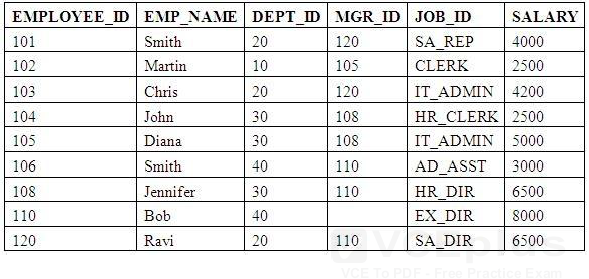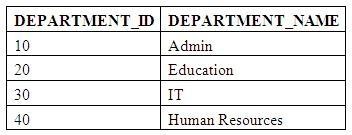EMPLOYEES and DEPARTMENTS data:
EMPLOYEES

DEPARTMENTS

On the EMPLOYEES table, EMPLOYEE_ID is the primary key. MGR_ID is the ID managers and refers to the EMPLOYEE_ID.
On the DEPARTMENTS table DEPARTMENT_ID is the primary key.
Evaluate this UPDATE statement.
UPDATE employees
SET mgr_id =
(SELECT mgr_id
FROMemployees
WHERE dept_id=
(SELECT department_id
FROM departments
WHERE department_name = ‘Administration’)),
Salary = (SELECT salary
FROM employees
WHERE emp_name = ‘Smith’)
WHERE job_id = ‘IT_ADMIN’;
What happens when the statement is executed?
A. The statement executes successfully, leaves the manager ID as the existing value, and changes the salary to 4000 for the employees with ID 103 and 105.
B. The statement executes successfully, changes the manager ID to NULL, and changes the salary to 4000 for the employees with ID 103 and 105.
C. The statement executes successfully, changes the manager ID to NULL, and changes the salary to 3000 for the employees with ID 103 and 105.
D. The statement fails because there is more than one row matching the employee name Smith.
E. The statement fails because there is more than one row matching the IT_ADMIN job ID in the EMPLOYEES table.
F. The statement fails because there is no ‘Administration’ department in the DEPARTMENTS table.

